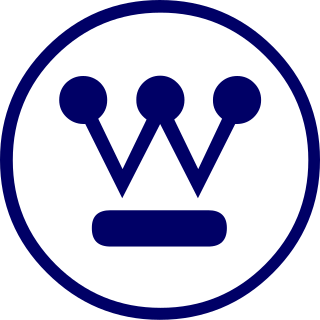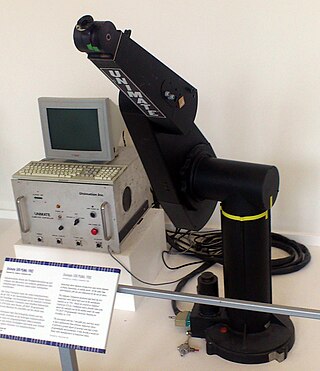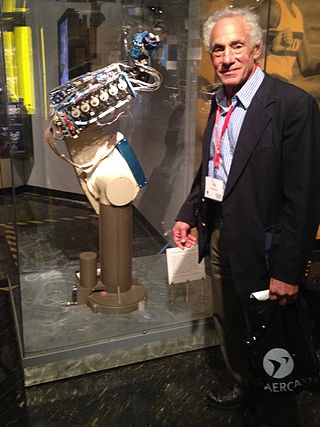
A robot is a machine—especially one programmable by a computer—capable of carrying out a complex series of actions automatically. A robot can be guided by an external control device, or the control may be embedded within. Robots may be constructed to evoke human form, but most robots are task-performing machines, designed with an emphasis on stark functionality, rather than expressive aesthetics.

An industrial robot is a robot system used for manufacturing. Industrial robots are automated, programmable and capable of movement on three or more axes.

Automation describes a wide range of technologies that reduce human intervention in processes, mainly by predetermining decision criteria, subprocess relationships, and related actions, as well as embodying those predeterminations in machines. Automation has been achieved by various means including mechanical, hydraulic, pneumatic, electrical, electronic devices, and computers, usually in combination. Complicated systems, such as modern factories, airplanes, and ships typically use combinations of all of these techniques. The benefit of automation includes labor savings, reducing waste, savings in electricity costs, savings in material costs, and improvements to quality, accuracy, and precision.

The Westinghouse Electric Corporation was an American manufacturing company founded in 1886 by George Westinghouse. It was originally named "Westinghouse Electric & Manufacturing Company" and was renamed "Westinghouse Electric Corporation" in 1945. The company acquired the CBS television network in 1995 and was renamed "CBS Corporation" until being acquired by Viacom in 1999, a merger completed in April 2000. The CBS Corporation name was later reused for one of the two companies resulting from the split of Viacom in 2005.

The PUMA is an industrial robotic arm developed by Victor Scheinman at pioneering robot company Unimation. Initially developed by Unimation for General Motors, the PUMA was based on earlier designs Scheinman invented while at Stanford University based on sponsorship and mentoring from robot inventor George Devol.

FANUC is a Japanese group of companies that provide automation products and services such as robotics and computer numerical control wireless systems. These companies are principally FANUC Corporation of Japan, Fanuc America Corporation of Rochester Hills, Michigan, USA, and FANUC Europe Corporation S.A. of Luxembourg.

George Charles Devol Jr. was an American inventor, best known for creating Unimate, the first industrial robot. Devol's invention earned him the title "Grandfather of Robotics". The National Inventors Hall of Fame says, "Devol's patent for the first digitally operated programmable robotic arm represents the foundation of the modern robotics industry."

Joseph Frederick Engelberger was an American physicist, engineer and entrepreneur. Licensing the original patent awarded to inventor George Devol, Engelberger developed the first industrial robot in the United States, the Unimate, in the 1950s. Later, he worked as entrepreneur and vocal advocate of robotic technology beyond the manufacturing plant in a variety of fields, including service industries, health care, and space exploration.
KUKA is a German manufacturer of industrial robots and factory automation systems owned by Chinese appliance manufacturer Midea Group.

Victor David Scheinman was an American pioneer in the field of robotics. He was born in Augusta, Georgia, where his father Léonard was stationed with the US Army. At the end of the war the family moved to Brooklyn and his father returned to work as a professor of psychiatry. His mother taught at a Hebrew school.

Unimate was the first industrial robot, which worked on a General Motors assembly line at the Inland Fisher Guide Plant in Ewing Township, New Jersey, in 1961.
Robot software is the set of coded commands or instructions that tell a mechanical device and electronic system, known together as a robot, what tasks to perform. Robot software is used to perform autonomous tasks. Many software systems and frameworks have been proposed to make programming robots easier.
Robotics is the branch of technology that deals with the design, construction, operation, structural disposition, manufacture and application of robots. Robotics is related to the sciences of electronics, engineering, mechanics, and software. The word "robot" was introduced to the public by Czech writer Karel Čapek in his play R.U.R., published in 1920. The term "robotics" was coined by Isaac Asimov in his 1941 science fiction short-story "Liar!"

A mechanical arm is a machine that mimics the action of a human arm. Mechanical arms are composed of multiple beams connected by hinges powered by actuators. One end of the arm is attached to a firm base while the other has a tool. They can be controlled by humans either directly or over a distance. A computer-controlled mechanical arm is called a robotic arm. However, a robotic arm is just one of many types of different mechanical arms.

The history of robots has its origins in the ancient world. During the industrial revolution, humans developed the structural engineering capability to control electricity so that machines could be powered with small motors. In the early 20th century, the notion of a humanoid machine was developed.

Omron Adept Technology, Inc. is a multinational corporation with headquarters in Pleasanton, California. The company focus on industrial automation and robotics, including software and vision guidance. Adept has offices throughout the United States as well as in Dortmund, Germany, Paris, France, and Singapore. Adept was acquired by Omron in October 2015.

Robots of the United States include simple household robots such as Roomba to sophisticated autonomous aircraft such as the MQ-9 Reaper that cost 18 million dollars per unit. The first industrial robot, robot company, and exoskeletons as well as the first dynamically balancing, organic, and nanoscale robots originate from the United States.
Stäubli is a Swiss industrial and mechatronic solution provider with four dedicated Divisions: Electrical Connectors, Fluid Connectors, Robotics and Textile.
The Japan Robot Association (JARA) is a trade association made up of companies in Japan that develop and manufacture robot technology. It was formed in 1971, as the Industrial Robot Conversazione and was the world's first robot association. The association was reorganized and renamed as the Japan Industrial Robot Association (JIRA) in 1972, and was formally incorporated in 1973. The name of the association was changed again in 1994 to its current one to accommodate non-industrial robots such as personal robots. Its headquarters are in Tokyo.















